
Thorunna australis
(Risbec, 1928)
Order: NUDIBRANCHIA
Suborder: DORIDINA
Family: Chromodorididae
DISTRIBUTION
Previously known only from New Caledonia and Christmas Island, Indian Ocean. New locality records in Forum from Philippines, Marshall Ids and Japan.
PHOTO
Christmas Island, Indian Ocean, April 1981, 15mm long alive, PHOTO: J.Hicks.
RELATED TOPIC
This species has some similarities to some colour forms of Hypselodoris maculosa but whereas that species has multiple longitudinal white lines Thorunna australis has only one on either side of the mantle. Both species have reddish bands on the rhinophores, always one in T. australis but up to three in H. maculosa.
Reference:
• Rudman, W.B. (1986) The Chromodorididae (Opisthobranchia: Mollusca) of the Indo-West Pacific: Noumea purpurea and Chromodoris decora colour groups. Zoological Journal of the Linnean Society 86(4): 309-353.
Rudman, W.B., 1998 (November 11) Thorunna australis (Risbec, 1928). [In] Sea Slug Forum. Australian Museum, Sydney. Available from http://www.seaslugforum.net/find/thoraust
Related messages
Thorunna australis on possible food, Mayotte Island
March 11, 2010
From: Matthias Deuss
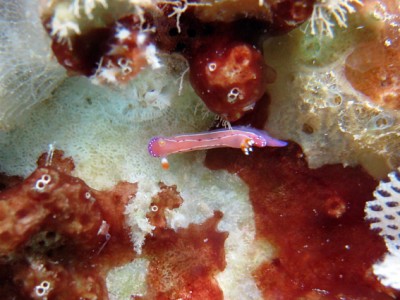
Dear Bill,
I found this little Thorunna australis under a dead Acropora coral. You may find its favorite food among all the sponges it's crawling on, though I can't spot any trace of feeding on these.
Locality: Bandrele inner reef, 2 metres, Mayotte Island, Comoros, Indian Ocean, 28 December 2009, Living coral area. Length: 10 mm. Photographer: Matthias Deuss.
Best wishes,
Matthias Deuss
matthias976@hotmail.fr


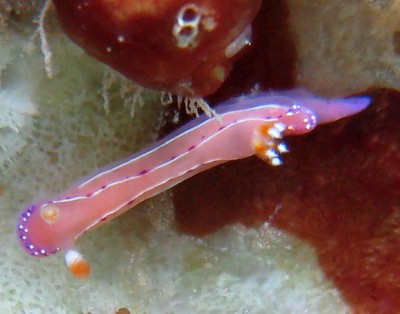
Dear Matthias,
These slugs don't make it easy for us. Sponge colonies in crevices are often mishapen and difficult to identify. In this case I think there is more than one species of sponge present and I suspect the whitish network on which the slug is crawling is not its food sponge but possibly a calcareous sponge. However on either side of your photo are bits of perhaps the same colony of another species, which could well be a species of Dysidea. We have two records on the Forum [#22474; #1201] showing this species feeding on a nondescript encrusting dysideid. Your message could represent a third record.
Best wishes,
Bill Rudman
Thorunna australis from Lembeh
May 21, 2009
From: Sylvain Le Bris

Concerning message #14907:
Dear Bill,
This is a new record for Thorunna australis for your forum. If my ID is correct.
Locality: Lembeh, 18 m, North Sulawesi, Indonesia, Pacific Ocean, 10 April 2009. Length: 15 mm
Regards,
Sylvain Le Bris
lebris.sylvain@gmail.com
Le Bris, S., 2009 (May 21) Thorunna australis from Lembeh. [Message in] Sea Slug Forum. Australian Museum, Sydney. Available from http://www.seaslugforum.net/find/22474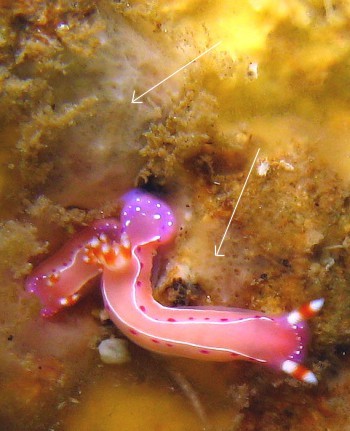
Dear Sylvain,
Yes this is T. australis. I am pretty sure the two animals have been feeding on the pale whitish sponge, [see marks in the lower photo], which has been almost completely covered by the yellow sponge. The whitish sponge is a species of Dysideawhich can be more clearly seen in Scott Johnson's earlier message [#1201]
Best wishes,
Bill Rudman
Thorunna australis from South Africa
October 10, 2005
From: Colin Ogden

Hi Bill,
I have another nudi that is confusing me.
Locality: Sodwana Bay, South Africa. Indian Ocean coast. Depth: 16 metres. Length: 5 mm. 1 October 2005. Coral reef. Photographer: Colin Ogden
At first I thought it was a tiny Hexabranchus sanguineus, but on further thinking, the closest I can come is the Hypselodoris maculosa. I am not happy about this so please can you help.
Thanks a ton
Colin
scubaco@iafrica.com
Ogden, C., 2005 (Oct 10) Thorunna australis from South Africa. [Message in] Sea Slug Forum. Australian Museum, Sydney. Available from http://www.seaslugforum.net/find/14907Dear Colin,
This certainly has the look of a juvenile Hexabranchus [message #14676], but I am glad you decided it wasn't, because this is a new find for the western Indian Ocean. It is Thorunna australis, which is at present known only from the western Pacific and Indonesian Archipelago. The orange bands on the gills and rhinophores, the rounded posterior end of the mantle with small rounded mantle glands, and the general colour pattern, are good characters for this species. Have a look at the Chromodoris decora colour group Fact Sheet
Best wishes,
Bill Rudman
Thorunna australis from Christmas Island
May 9, 2002
From: W.B. Rudman

Here is some information and photos on Thorunna australis from John Hicks' Christmas Island, Indian Ocean collections.
PHOTO: AM C129116, 15 mm long alive. 25 April 1981, off North Arm of Cantilever, 10 m, on top of coral rock, Christmas Is., Indian Ocean. Photo: John Hicks
Best wishes,
Bill Rudman
Re: Thorunna australis from Tokyo
September 11, 2000
From: Hitoshi Ono
Dear Bill,
Thank you for your answer to my question. I'm very happy if it helped your study.
See you!
Hitoshi Ono
hal9001@green.ocn.ne.jp
Ono, H., 2000 (Sep 11) Re: Thorunna australis from Tokyo. [Message in] Sea Slug Forum. Australian Museum, Sydney. Available from http://www.seaslugforum.net/find/3007Thorunna australis? from Japan
September 7, 2000
From: Hitoshi Ono
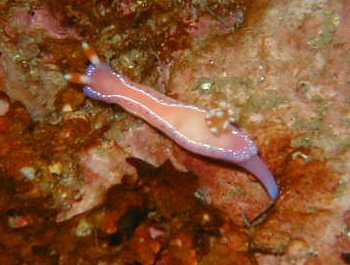
Dear Bill,
Your WebPage is so instructive for me. I often check a sea slug. Thanks a lot!
By the way, last week I found a sea slug in Tokyo Bay during fun diving.
I wonder it is a Thorunna australis. But I have doubt my idea because the place it was found is far from the location on your species list.
Situation.
Date:26 August 2000
Location:Tateyama, a point of Boso peninsula in Tokyo Bay
Depth: 20m.
Water temperature: 23deg C
Area: on a rock.
Hitoshi Ono
hal9001@green.ocn.ne.jp
Ono, H., 2000 (Sep 7) Thorunna australis? from Japan. [Message in] Sea Slug Forum. Australian Museum, Sydney. Available from http://www.seaslugforum.net/find/2972Dear Hitoshi,
Your animal is indeed Thorunna australis. Don't doubt your eyes if they disagree with something in the Forum. The exciting thing about science is finding new things and making new observations. I try to keep the Forum as up to date as possible but there will always be things that need correcting or updating as we make new observations. If you look at the messages on the Thorunna australis page there are also new records from the Philippines and the Marshall Ids, so I have updated the information on distribution.
I also note that Atsushi Ono has a photo of Thorunna australis from Kerama Ids so we can definitely say that it is found as far north as Japan. Thanks again for the record from Tokyo Bay, it is very interesting.
Best wishes,
Bill Rudman
Thorunna australis? from Philippines
June 19, 2000
From: Erwin Koehler
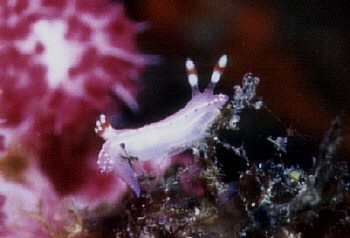
Dear Bill,
This one is from the Philippines, Cebu Is., divesite "Canyon reef",
March 2000, depth 15 m, size approx.2 cm.
The photo is by Hans-Hermann Harms. I think it looks like Thorunna australis.
Erwin
Medslugs.Koehler@t-online.de
Koehler, E., 2000 (Jun 19) Thorunna australis? from Philippines. [Message in] Sea Slug Forum. Australian Museum, Sydney. Available from http://www.seaslugforum.net/find/2596Dear Erwin,
Much of the colour seems to have been washed out of the photo, but from what I can see, including the red bands on the rhinophores and gills, I agree that it is probably Thorunna australis.
Best wishes,
Bill Rudman.
Thorunna australis in the Marshall Is.
August 18, 1999
From: Scott Johnson
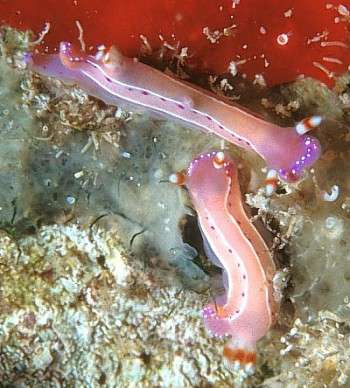
Hi Bill,
Attached is some photographic evidence that Thorunna australis occurs as far east as the Marshall Islands. It is relatively common at Kwajalein and Enewetak Atolls. This pair is on its typical prey sponge, a light grayish brown encrusting species. Also, the larger of the two is carrying around a commensal copepod.
Scott
johnson@kmr.ll.mit.edu
Johnson, S., 1999 (Aug 18) Thorunna australis in the Marshall Is.. [Message in] Sea Slug Forum. Australian Museum, Sydney. Available from http://www.seaslugforum.net/find/1201Dear Scott,
Thanks for the distributional information and the great photo. If colour is anything to go on in copepod taxonomy, I think I have found it on a number of nudibranchs. That white cross-like mark on its carapace is fairly characteristic - though for all I know it may be a family characteristic in copepods! See my photo of one on a phyllidiid.
A feature of great interest is the swollen orange region at the posterior end of the mantle in both animals. This is where the main mantle glands are concentrated in this species, but I have never seen them so obvious as in this photo.
Bill Rudman.
